Are confused about between a feral cat and a semi feral cat? Do you want to know the signs of a semi feral cat and what differentiates them from feral cats? Keep reading to know the signs of a semi feral cat and their unique behavior.

Understanding the behavior and traits of a semi feral cat is essential for their proper care and management.
These cats exhibit distinct characteristics that differentiate them from domesticated pets, making it crucial to identify their signs for better understanding and handling.
Also, recognizing these signs empowers caretakers, allowing for a more tailored approach to ensuring the well-being of these unique felines. Here, you will get to know the eight key signs that indicate a semi feral cat.
Also, we will equip you with the knowledge to address their specific needs and behaviors.
Signs of a Semi Feral Cat

To know if your cat is semi feral cat, here are what to take note of:
1. Skittish Nature and Fear of Humans
Semi feral cats, unlike fully domesticated felines, tend to exhibit a skittish and wary attitude toward humans.
Also, they are often extremely cautious and fearful when approached, displaying tendencies to hide or retreat when people are near.
This behavior stems from their lack of exposure or socialization to human interaction during their formative years.
2. Avoidance of Close Human Contact
Semi feral cats tend to maintain distance and avoid physical contact with humans.
Unlike domesticated cats that may seek affection and attention, semi feral cats may appear aloof and uncomfortable with close interaction.
They might not enjoy being petted or held and may shy away or become defensive when approached.
3. Preference for Solitude and Outdoor Environment
Semi feral cats generally favor a solitary lifestyle and are more comfortable in an outdoor environment.
In addition, they exhibit a strong inclination towards independence and tend to roam freely.
Their need for open space and a sense of freedom is greater compared to fully domesticated cats.
4. Limited Vocalization and Communication
In contrast to the expressive nature of many domestic cats, semi feral cats exhibit limited vocalization.
Interestingly, they communicate through subtle body language and gestures, often preferring to remain quiet.
This subdued behavior contributes to their overall reserved nature.
5. Difficulty in Socializing with Other Pets
Their upbringing or lack of early socialization can lead to challenges in cohabiting with other household pets.
Semi feral cats may find it challenging to adapt to sharing space and might exhibit aggression or avoidance when introduced to other animals.
6. Self-Sufficiency in Hunting and Survival Skills
Semi feral cats display impressive hunting and survival skills.
Interestingly, their upbringing in the wild or semi-wild environment has honed their ability to fend for themselves.
They might hunt for their food and display adeptness in surviving in various environments.
7. Territorial Behavior and Marking
Semi feral cats are notably territorial and may display marking behavior by spraying or scratching areas to establish their territory.
Also, this instinctual behavior is more pronounced in semi feral cats than in fully domesticated ones.
8. Resistance to Domestication
Their inherent wild or semi-wild nature makes it challenging to domesticate them fully.
Efforts to tame or acclimate them to a typical indoor lifestyle may be met with resistance and stress.
In conclusion, understanding these signs and behaviors is pivotal in providing appropriate care and support to semi feral cats.
Their needs differ from those of fully domesticated cats, and recognizing these distinctions is vital in ensuring their well-being and harmonious coexistence in diverse environments.
Related Searches:
